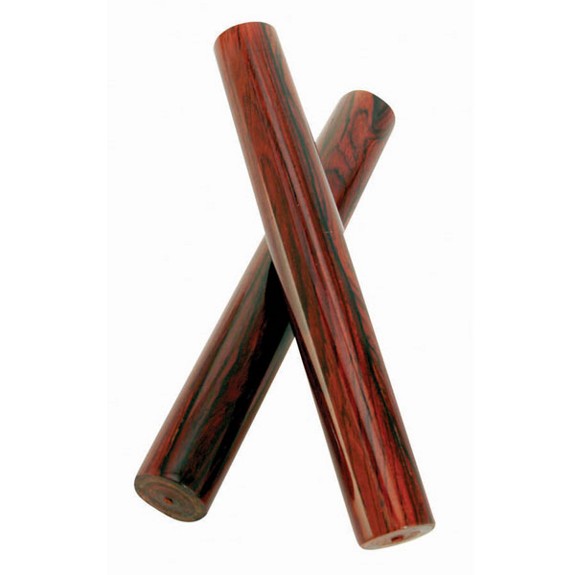Introduction
The name clave (spanish for “key”) originally referred to a rhythm instrument consisting of two round wooden sticks. In Latin American music, the clave plays repetitive rhythm patterns, which are now also referred to as clave rhythms. Depending on the musical style, there is the “Son Clave“, “Rumba Clave” and “Bossa Nova Clave“. Often these rhythmic patterns can be heard more or less clearly in the rhythm sections of the respective bands.
The importance of the clave can be compared to the 4/4 meter in Western music. It is the basic unit of rhythmic variations and the point of reference for all other instruments. In contrast to the traditional accents of 4/4 time (in the basic pulse 1 2 3 4, with an emphasis on 1 and 3), the accents in Latin American music are more varied. For example, a beat is often stressed every three eighth notes rather than every two or four.
This results in repetitive, two-bar rhythm patterns that can be played in the form of 3-2 or 2-3. 3-2 means that three beats are played in the first bar and two in the second bar, with 2-3 it is vice versa.
In the following examples the clave is notated in the lower voice. In the upper voice the fundamental pulse is notated in quarter notes for reference. The following procedure is recommended for preparing the material:
While clapping the clave with your hands…
- …mark the basic pulse (1 2 3 4) with your foot.
- …just tap on 1 and 3 with your foot.
- …feel the clave as a basic rhythm without any further grid.

The Son - Clave
The most famous clave originates from the cuban Son music. The tresillo (the rhythm pattern with three accents) is identical to the rhythmic figures from tango/milonga/habanera and many other world music rhythms. Listen to “El Cuarto de Tula” from the famous Buena Vista Social Club album. Try to recognize which of the two claves is being played continuously in the background:

The Rumba - Clave
Like the son, the rumba is of Cuban origin. The boundaries between the various Afro-American styles are fluid. They are also closely related to jazz and blues rhythms and are therefore universal cornerstones of our modern music. The special feature of the rumba clave is the shifting of the last note of the 3-note unit by an eighth note. This gives the rhythm a nice swinging forward movement.

The Bossa Nova - Clave
In the music of Joao Gilberto or Tom Jobim, the clave is not that important (Gilberto’s way of treating the guitar as a rhythm instrument, however, resembles the musical meaning of a clave). The trademark of the bossa nova clave is the shift in the rhythm of two. In the 2-3 variant, there is an interesting rhythmic pattern: from the first beat (on the 2nd quarter of the first bar) one beat is played for every three eighth notes. This creates a nice “rhythmic dissonance” to the fundamental pulse, which sounds every two eighth notes.
In larger band formations, the drummer often adopts the clave pattern on the snare drum. Quincy Jones played jazz trumpet, produced Michael Jackson’s albums and obviously also liked bossa nova:

Don’t transfer the clave to the guitar until you feel comfortable with the rhythms. As with the basic bossa nova rhythm the thumb takes over the function of the basic pulse (in half notes, i.e. on beats 1 and 3). The fingers pluck the clave rhythm on the upper strings. If you want to dive straight into a song arrangement with a clave pattern, you can try out Menina Moca by Luiz Antonio.
Even if these rhythms are often not used directly in guitar pieces, they are part of the modern basic vocabulary and noticeably expand your rhythmic security. In the chapter on the Brazilian Partido Alto rhythm you will find more rhythms and examples of use to expand your guitar playing.